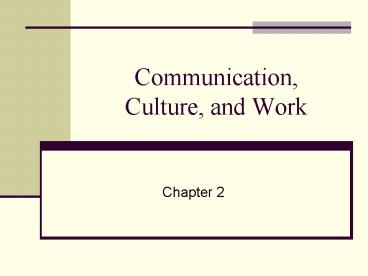Communication, Culture, and Work - PowerPoint PPT Presentation
1 / 15
Title:
Communication, Culture, and Work
Description:
Culture a learned set of values, beliefs, norms, customs, rules, or codes that ... the organization feel about tattoos, piercings, attire, communication flow, ... – PowerPoint PPT presentation
Number of Views:306
Avg rating:3.0/5.0
Title: Communication, Culture, and Work
1
Communication, Culture, and Work
- Chapter 2
2
Composition of the U.S., 1999
3
Composition of U.S., 2025
4
The Nature of Culture
- Culture a learned set of values, beliefs,
norms, customs, rules, or codes that lead people
to define themselves as a distinct groups, giving
them a sense of community. - We cannot easily see or identify the
characteristics of our own culture. Why?
5
Cultural Differences in Business
- Formality
- Social Customs
- Style of Dress
- Time
- Tolerance of Conflict
- Gender Roles
6
Fundamental Values in Cultures
- Why do some people openly embrace conflict while
others shy away? - Why do some cultures values individuality while
others desire group unity? - Why do some people run perpetually late while
others are early? - Some of these questions can be answered by
looking at cultural differences!
7
Cultural Contexts
- Low-Context
- Use language to express meaning.
- Ideas are clear and logical.
- Rely on written contracts.
- U.S., Germany, Canada, Sweden.
- High-Context
- Relies on subtle, nonverbal cues.
- Message comes from the context.
- Reluctant to embarrass, so uses nonverbals to
comm. - Japan, China, Middle Eastern cultures
8
Individual versus Collectivism
- Individualism
- Puts own interest ahead of social concerns.
- Focus on personal success and advancement.
- U.S., Canada.
- Collectivism
- Loyal to the group or organization.
- Welfare of individual not as significant as
groups well being. - Asian cultures like Japan, Guatemala, Panama.
9
Power Distance
- High Power Distance
- Power is distributed unevenly.
- Recognized that some people are in higher
positions than others. - Respect for those in higher position.
- Mexico, China, Philippines.
- Low Power Distance
- Power is not flaunted or emphasized.
- Others feel comfortable approaching or
challenging authority. - Respect is earned rather than based on position.
- Austria, U.S., New Zealand, Ireland.
10
Diversity at Home
- Co-culture groups that have a clear identity
within the majority culture. - Regional Differences
- Gestures, eye contact, vocabulary
- Ethnicity
- Race, gender, country
- Disabilities
- Physical disabilities
11
Stages of Intercultural Sensitivity
- Denial no differences
- Defense hostility toward other cultures
- Minimization differences are superficial
- Acceptance recognition and exploration of
differences - Adaptation Ability to empathize, shift frame of
reference - Integration recognize and embrace differences
12
Communicating Across Diversity
- Become culturally literate.
- View diversity as an opportunity.
- Avoid ethnocentrism.
- Dont condescend.
- Talk about differences.
13
Organizational Culture
- Organizational culture a relatively stable,
shared set of rules about how to behave and set
of values about what is important. - The way things are around here.
- How does the organization feel about tattoos,
piercings, attire, communication flow, personal
days, personal phone calls, etc?
14
Dimensions of Organizational Culture
- Sociability
- Power distribution
- Degree of structure
- Achievement awards
- Opportunities for growth
- Tolerance for risk and change
- Conflict tolerance
- Emotional support
15
Organizational Culture and Career Planning
- Study the physical setting.
- Read what the company says about itself.
- Test how the company greets strangers.
- Interview company people.
- Learn how employees spend their time.































